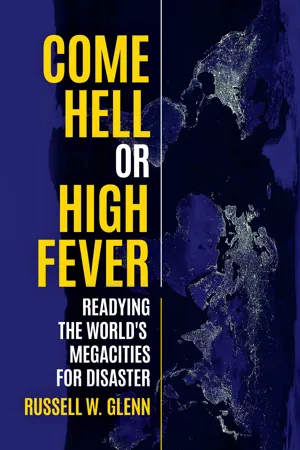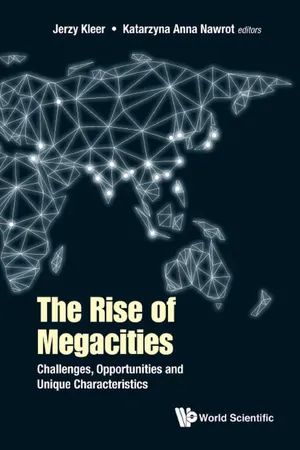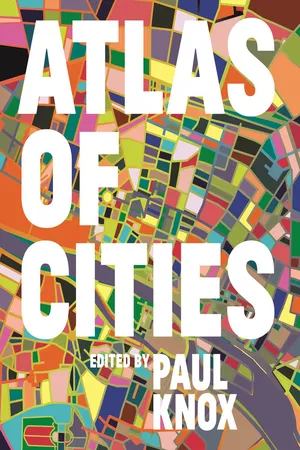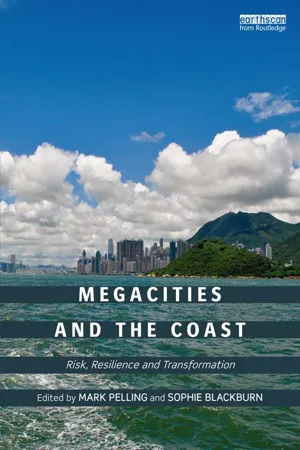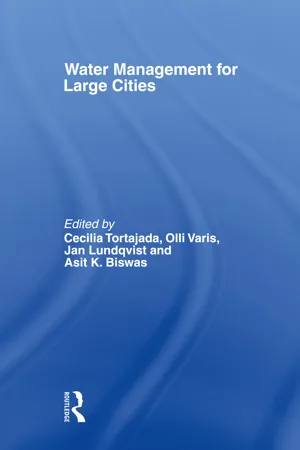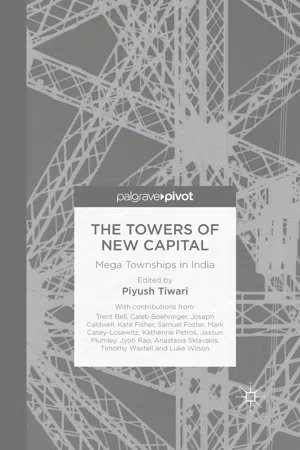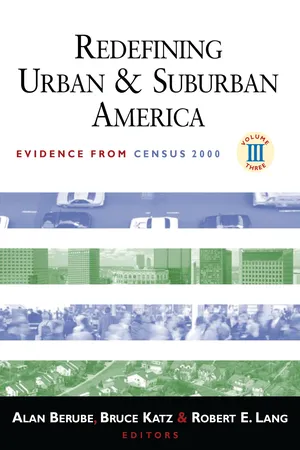Geography
Megacities
Megacities are urban areas with populations exceeding 10 million people. These densely populated cities often face challenges related to infrastructure, housing, transportation, and environmental sustainability. Megacities are significant in shaping global economic, social, and cultural dynamics, and they play a crucial role in understanding urbanization and its impacts on the environment and society.
Written by Perlego with AI-assistance
Related key terms
1 of 5
11 Key excerpts on "Megacities"
- eBook - PDF
Come Hell or High Fever
Readying the World's Megacities for Disaster
- Russell W Glenn(Author)
- 2023(Publication Date)
- ANU Press(Publisher)
COME HELL OR HIGH FEVER 50 economic, political, social and diplomatic connections; and a related influence that reaches far beyond local rural areas and very likely beyond national borders and nearby countries to extend to locations worldwide— all these are features found in many of the planet’s largest urban areas. One must take all into account when planning for or responding to a disaster. Relying on longstanding definitions of a megacity based on population alone (at one time, any urban area with more than 1 million; later, any with more than 5, 8, then 9 and now 10 million, although at least one organisation still goes with 8 million) fails to take these other vital considerations into account. 104 Avoiding the temptation to add another urban term to the already too many, we will, as said, instead retain a definition for ‘urban area’ already in use but recognise that a megacity is much more than merely a large population, defining it as ‘an urban area of extraordinary population size, geographic spread, physical and social complexity, interconnectedness, and similarly exceptional characteristics, to include influence with at least national and broader regional scope’. 105 More wordy than desirable, perhaps, but this is a definition that captures the varied aspects that make Megacities stand out from less exceptional cities. Some cities of more than 10 million do not qualify for megacity status using this definition. Though China’s Tianjin and Chengdu have populations of more than 13 and 12 million, respectively, their broader regional and worldwide influence are limited. Tianjin’s primary role is to act as Beijing’s port; Chengdu’s claims to fame are its popularity as a tourist destination and related status as home to giant pandas. The same might be argued for Dhaka, Bangladesh, which, with its 14.6 million residents within 324 square kilometres, is the most densely populated large city in the world. - eBook - ePub
The Rise of Megacities
Challenges, Opportunities and Unique Characteristics
- Jerzy Kleer, Katarzyna Anna Nawrot(Authors)
- 2018(Publication Date)
- WSPC (EUROPE)(Publisher)
When interpreted in these categories, the future of Megacities may be seen through lenses of a positive development scenario, the main driving force of which, however, would have to be long-term economic and social development, a progress taking place at the level of individual countries and world regions. This, in turn, would depend upon a host of external political, environmental, as well as other preconditions. An alternative scenario is one of their continuing rapid, chaotic expansion, to be accompanied by growing internal tensions, and leading towards breakages of basic infrastructure and a decline of functions performed, a consequence of which would be a dwindling number of workplaces, and an initially selective, but in a longer perspective large-scale population outflow. Such a course of events could be initiated at a local or regional level by a massive, city-bound population exodus from rural areas, an effect of natural disasters, and a general deterioration of environmental conditions related to climate change. Once their absorption capacity was exceeded, the Megacities could no longer fulfil their complex functions of integrating local economies into global economic circuit. With regard to spatial population flows, their position would change from one of the important destinations to that of mainly origins of migration and refugee movement, on both internal and international scale.3.4.Discussion and ConclusionsGlobal interdependence of large city development, which is of multidimensional character, has been studied extensively by focusing on functional network relations (Taylor, 2004; Derudder et al., 2012). This work is devoted to a brief discussion of some of its other aspects, those that pertain to structural properties of urban centres, as well as to their possible future development trajectories.As noted earlier, whereas in Europe or North America, major cities are perceived as metropolitan by referring to qualitative criteria primarily; elsewhere, the large urban centres, whose position on a global scale is recognized, are identified mainly by the population size, and tend to be labelled as Megacities (Parnreiter, 1999, 2012). - eBook - PDF
- Paul Knox(Author)
- 2022(Publication Date)
- Princeton University Press(Publisher)
Megacities are unevenly distributed around the world. More than half, including the seven biggest, are located in Asia. Interestingly, there are only a few in the West: New York and Los Angeles in the United States, with Paris as the lone megacity in Europe, though it will soon be joined by London. The fact that the majority of Megacities are found in what is generally considered the “developing world” raises some important questions about how Megacities come about and how desirable they are. Size matters. Cities are generally deemed beneficial because they offer economies of scale: it becomes cheaper and more efficient to provide a host of services or to engage in economic activity when people are close together. Thus, urbanization is commonly seen as part and parcel of modernization and progress. But is it possible that cities can get too big, and the advantages give way to The Megacity 143 Moscow Karachi Cairo Dhaka Paris Mumbai Lagos Kolkata Istanbul Delhi Tehran Beijing Guangzhou-Foshan Tokyo-Yokohama Manila Seoul-Incheon Shenzhen Osaka-Kobe-Kyoto Jakarta Nagoya Bangkok Shanghai diseconomies of scale? What if distances across the urban area are too extensive? What if commuting becomes too costly? What about the ecological footprint of Megacities? How important is population density, apart from size? And what if Megacities are not actually planned, as appears to be the case in much of the less developed world? This chapter highlights the emergence of Megacities in recent times, the considerable variation among them, and some of their main features and challenges. - eBook - ePub
Megacities and the Coast
Risk, Resilience and Transformation
- Mark Pelling, Sophie Blackburn(Authors)
- 2014(Publication Date)
- Routledge(Publisher)
The purpose of this section is to highlight some of the most significant trends in coastal megacity development, which have bearing on the nature of risk and opportunity in these areas. Note that due to the large degree of contradiction and debate which surrounds megacity growth statistics, what is presented here is an overview of key narratives. It should also be noted that many of the issues identified are not limited to the spatial fixidity of coastal Megacities – that is, they are more to do with cities than with the coast and also apply in non-coastal contexts – however, they are of particular significance in coastal Megacities due to the concentration of risk, assets and environmental sensitivity in these areas as previously outlined. Given the difficulties outlined above, a broad definition of Megacities and urban regions is adopted.4.1 The ‘new’ Megacities: growth in low-and middle-income countries
Between 1975 and 2000, the number of Megacities in low-and middle-income countries rose from two to 13, with the global megacity population increasing more than seven-fold to 165 million (more if wider agglomeration boundaries are drawn) (Cohen 2006). Looking at Plate 1 , of the seven new Megacities anticipated by UN-HABITAT to emerge by 2025, all are in low-or middle-income countries with only four remaining in developed countries. Even more significantly, by 2011 three of these projections have already become reality, with Lagos, Shenzhen and Guangzhou already having passed ten million in population – and Jakarta is not far behind (UN-DESA 2012b). That two Chinese cities have done this reflects the ‘staggeringly high’ growth rates being experienced in China, which exceeded 10 per cent in 2008 (UN-HABITAT 2008).These data indicate that generally, urban growth rates are higher in Asia, Africa and Latin America compared to the ‘older’ Megacities in Europe, North America and Japan. Nevertheless despite the rapid growth of these ‘new’ Megacities, recent reports are keen to dispel popular visions of a future led by ‘explosive’ urbanisation – a myth largely driven by Megacities’ high visibility and the media (Satterthwaite 2010). Whilst it is true that Megacities have grown in size and number in the last few decades, this growth has been much slower than expected – particularly in high-income nations (Angel et al. - eBook - PDF
- Ronan Paddison(Author)
- 2000(Publication Date)
- SAGE Publications Ltd(Publisher)
Although there continues to be a substantial number of cities with large populations in MDCs, large LDC agglomerations are beginning to outnumber these. In addition, looking at the distribution of the urban population by city size, we noted that more and more of this population is inhabiting the world’s mega cities, which have populations of over 10 million, and more of these mega cities are becoming common in LDCs. Judging by current 24 Handbook of Urban Studies city growth rates, the future will see an even greater expansion in the number of these largest agglomerations in Asia and Africa. DEFINING THE CITY Thus far the discussion of urban centres and urban growth has taken place without any specific denotation of what we mean by the term ‘urban’ or ‘urbanization’, or how a city is defined. We now will move on to this topic. Criteria for Defining an Urban Area The city and the concept of urban are interre-lated, and in order to define a city it is necessary to first establish what is meant by urban. We may consider the city, in fact, to be an administrative definition that places a boundary on a contiguous urban area. Problems in terms of analysis arise when urban is defined differently across adminis-trative and national boundaries. Generating a specific definition is difficult. The difficulty arises from the fact that the concept of urban, from which city boundaries are determined, is an abstraction that involves a series of interrelated factors, some of which are: population size; popu-lation density; space; economic and social organ-ization; economic function; labour supply and demand; and administration. Yet, for practical statistical collection purposes, national statistical definitions often identify urban places in terms of criteria such as administrative boundaries or in terms of size of population living in a given area. - eBook - ePub
- Cecilia Tortajada, Olli Varis, Asit Biswas, Jan Lundqvist(Authors)
- 2013(Publication Date)
- Taylor & Francis(Publisher)
This implies that in 2025, at the global level, rural areas will have to supply food, energy and other commodities to towns and cities that will house almost twice as many people as the rural areas do. The global cycles of carbon, nutrients, water and other substances will be notably distorted, while markets perturb age-old social systems.The aim of this paper is to outline the world's urban development, and in particular the growth of the largest agglomerations, known as Megacities. This analysis draws attention to nine that have been selected to provide a comprehensive analysis of water management in Megacities. The cities and the evolution of their populations are presented in Figure 1 .Urbanization, Megacities and Development: A Global Outlook
Let us continue to adopt the perspective of mankind only one generation ahead in time—the shortest possible span for any consideration of sustainable development. Each year, the world population grows by some 70 million. Almost all of this is urban growth in developing countries, although mainly it is due to migration; fertility rates are far lower in urban areas than in rural ones (UN, 2002). Urbanization and rural and urban population by continents is shown in Figure 2 .In Africa and in Asia, the proportion of urban population to rural is around 1:3, while in all the other continents it is more than 2:3. Therefore, urbanization is expected to be most rapid in Asia and in Africa (Figure 1 ). In China, it has been estimated that by 2025 the urban population will have grown by 350 million. China's cities currently house ‘only’Figure 1 World's biggest cities in 2015 with Johannesburg. Population growth between 1985 and 2015 is shown. Names of the study cities are highlighted in bold type. Source : UN (2002).500 million, and they already face severe problems of environmental and resource degradation.Figure 2 Rural and urban population by continent. Note : In the upper graph, the upper columns represent urban population and the lower ones rural population. Source : UN (2002).Megacities
Urbanization is seen most dramatically as the growth of large urban agglomerations. The UN uses the term ‘megacity’ for one that has more than 5 million inhabitants; a ‘big city’ has more than 1 million. These terms are used also in this text. Whereas in 1985, there were 31 Megacities on this planet, the number had grown to 40 by 2000, and is expected to grow to 58 by 2015. - eBook - PDF
New Mega Trends
Implications for our Future Lives
- S. Singh(Author)
- 2012(Publication Date)
- Palgrave Macmillan(Publisher)
5 URBANISATION: FROM MEGA-CITIES, MEGA-REGIONS, MEGA-CORRIDORS AND MEGA-SLUMS TO MEGA OPPORTUNITIES MEGA-CITIES, MEGA-REGIONS, MEGA-CORRIDORS AND MEGA-SLUMS Mahatma Gandhi once said, 'India is to be found not in its few cities but in its 700,000 villages.' Though that may at one time have been true, it is no longer the case. With about 30 country bumpkins mov- ing lock, stock and barrel every minute from Indian villages to become city dwellers, not many villages will be left in India by the end of this century. Towards the end of the last decade, our planet achieved a remarkable feat. For the first time in human history, SO% of the world's popula- tion was living in urban areas. Indeed, the UN predicts that by 2030 60% of the world's population will live in cities. 1 A study I recently led at Frost & Sullivan actually summarised the urbanisation trend to be growing faster than the UN's prediction, and forecast the urban population to reach 4.6 billion globally around 2025- about 60% of the total world population. 2 In other words, the world is creating a city the size of Barcelona as five million people become urban residents every month. This extraordinary growth will lead to the merger of core city centres or downtowns with suburbs and daughter cities, resulting in the expansion of city limits. As a result, we will see the emergence of Mega-cities, Mega-regions, Mega-corridors and - sadly - even Mega-slums. More than 35 cities globally by 2025 will merge with their suburbs and become Mega-cities boasting populations in excess of eight million and a GOP contribution of $250 billion. A good example of a Mega-city is my home city, London. The city has expanded to its 61 NEW MEGA TRENDS suburbs and sprawls all the way to the outer motorway- the M25, one of the world's longest orbital roads -which some of us call the longest and biggest parking lot in the UK. - eBook - PDF
The Constitution of the City
Economy, Society, and Urbanization in the Capitalist Era
- Allen J. Scott(Author)
- 2017(Publication Date)
- Palgrave Macmillan(Publisher)
11 Moreover, the current historical period is one in which massive metro- politan aggregates or superclusters are increasingly forming as a conse- quence of the spatial coalescence of individual metropolitan areas. Several different terms have been devised to designate any supercluster of this sort, including polycentric metropolis, megaregion, and global city-region. 12 Hall and Pain describe this phenomenon as “a new form [comprising] a series of anything between 10 and 50 cities and towns, physically separate but functionally networked, clustered around one or more larger central cities.” 13 In the circumstances, it is entirely within the bounds of possibility that we will eventually see some type of overall—but as yet indecipherable— redefinition of the global urban continuum to take account of supercluster formation, possibly in combination with some decay in country-specific rank-size regularities. Certainly, while more or less orderly national urban continua remain strongly inscribed on the landscape of most countries, these are becoming ever more firmly integrated into an explicitly global space of flows and increasingly assertive networks of superclusters, and the long-run effects of these trends will undoubtedly turn out to have major impacts on both local and global patterns of urbanization. 14 THE URBAN CONTINUUM 88 THE GEOGRAPHY OF URBAN GROWTH AND DEVELOPMENT Throughout the history of capitalism, cities have grown and spread with remarkable persistence. Much of this expansion can be ascribed to rising levels of output, productivity, and per capita income in both manufactur- ing and service systems and the concomitant but selective pressures on significant portions of the capitalist production system to agglomerate in geographic space. - eBook - ePub
The Towers of New Capital
Mega Townships in India
- P. Tiwari(Author)
- 2016(Publication Date)
- Palgrave Macmillan(Publisher)
1 The Challenge of Megacities in India Piyush TiwariAbstract:This chapter sets the stage for discussion in the book by briefly presenting the political, economic and urban context within which mega townships’ development has been envisaged to be at the forefront of India’s aspiration to become a global economy. The chapter also outlines the key literature on the topic. With mega townships as the tool, this book analyses complexity, scale and challenges associated with the development paradigm in India. The chapter also introduces to the readers the interdisciplinary lenses through which mega townships have been analysed in the book.Tiwari, Piyush, ed. The Towers of New Capital: Mega Townships in India . Basingstoke: Palgrave Macmillan, 2016. DOI : 10.1057/9781137586261.0005.IntroductionGlobalization has manifested itself in numerous ways – economic, political and social – bestowing its benefits through economic growth and rise in income across nations in global north and south. The past two decades have witnessed phenomenal economic growth in emerging economies like India, China, Brazil, Russia, South Africa and emergence of cities in these economies as crucible of energy and abundant human activity. Now cities in the developing world aspire to become a ‘world city’ or a ‘global city’ as their economies link up with the international markets. In order to attract capital, nations’ governments have started to intervene through space-based interventions in urban regions (Brenner, 1998). Some examples of such interventions (termed ‘global fixes’ by Brenner, 1998) in India are Special Economic Zones or mega townships on the fringes of the existing Megacities. As strategies of territorial restructuring, these projects are socially produced and intended to facilitate capital investment and accumulation (Kennedy et al., 2011, quoting Brenner, 1998). There is increasing evidence that policymakers in emerging countries are adopting city-centric strategies, but there is significant variation in the specific model used which depends on each country’s economy; its engagement with global capitalism; and local, social and political institutions (Kennedy et al., 2011); India is no exception and the model, albeit with its many variants, has largely been space-based, infrastructure-led intervention. - eBook - PDF
Redefining Urban and Suburban America
Evidence from Census 2000, Volume III
- Alan Berube, Bruce Katz, Robert E. Lang, Alan Berube, Bruce Katz, Robert E. Lang(Authors)
- 2007(Publication Date)
- Brookings Institution Press(Publisher)
Like metropolitan areas, micropolitan areas are constructed from counties containing the population center, and those that have commuting relationships with the central county. 235 10 m Robert E. Lang and Dawn Dhavale a metropolitan area. But micropolitan areas reverse this standard pattern: they grow to metropolitan scale without a large central city. Some of the largest micropolitan areas are more than just overgrown small towns—they appear to be exemplars of a new decentralized or even countrified city. Most research on decentralized cities (for example, edge cities and edgeless cities) looks at the places that have grown next to tradi-tional cores, such as Tysons Corner, Virginia, outside of Washington, D.C. 3 Yet the suburban growth in big micropolitan areas is not outside anything, because there is no real center, no urban area to be a suburb of. Micropolitan areas therefore represent a new metropolitan form with an expansive periphery and a relatively small core. METHODOLOGY In the study described in this chapter, we looked at the 567 micropolitan areas that lie within the continental United States, excluding those in Alaska, Hawaii, and Puerto Rico, which tend to be outliers. For example, there are remote Alaskan micropolitan areas that are actually closer to Seattle than Anchorage. In Hawaii, three entire islands are micropolitan areas. This chapter focuses on three basic dimensions of place—size, growth, and location. Micropolitan area location is especially important because it significantly affects the first two qualities. Our analysis shows that micro-politan areas proximate to big metropolitan areas tend to be bigger and faster-growing, whereas the more remote places are often smaller and slower growing. This finding is consistent with geographer Calvin Beale's work that established remoteness as a critical indicator of metropolitan development. - eBook - PDF
- Roger L. Mackett, Anthony D. May, Masanobu Kii, Haixiao Pan, Roger L. Mackett, Anthony D. May, Masanobu Kii, Haixiao Pan, Stephen Ison, Jon Shaw(Authors)
- 2013(Publication Date)
- Emerald Group Publishing Limited(Publisher)
In this sense, the urban growth estimated here could be interpreted as the autonomous dynamics of human settlement without the intervention of the will of decision makers. Some of the results of our study indicate an extreme concentration of population in Megacities in developing countries, which might be undesir-able for national security, individual quality of life, and sustainable development. If it is undesirable, there are measures and instruments to control this urban growth and development. One example would be a transport policy which could serve as a dispersion force for population concentration. These results could serve to stimulate discussions on urban/ national land development policy and planning. This study is ongoing, and there are many issues to be addressed, including the data quality and reliability, accuracy of the agglomeration formation mechanisms, location suitability factors for city locations and constraints on urban growth such as water resource limitations. Among these issues, improving the data quality for urban populations is essential for further study. At present, there is no exhaustive dataset for the geographical distribution of urban populations. The development of a statistical database and its maintenance system will contribute to future studies on urban activities and related policy research. ACKNOWLEDGEMENT This study is partly supported by KAKENHI (23760490). REFERENCES Albert, R., & Baraba´ si, A. L. (2002). Statistical mechanics of complex networks. Reviews of Modern Physics , 74 , 47–97. Asadoorian, M. O. (2008). Simulating the spatial distribution of population and emissions to 2100. Environmental and Resource Economics , 39 , 199–221. MASANOBU KII AND KENJI DOI 40 Barabasi, L., & Albert, R. (1999). Emergence of scaling in random networks. Science , 286 , 509–512. Becker, J. J., Sandwell, D. T., Smith, W. H. F., Braud, J., Binder, B., Depner, J., y Weatherall, P.
Index pages curate the most relevant extracts from our library of academic textbooks. They’ve been created using an in-house natural language model (NLM), each adding context and meaning to key research topics.
